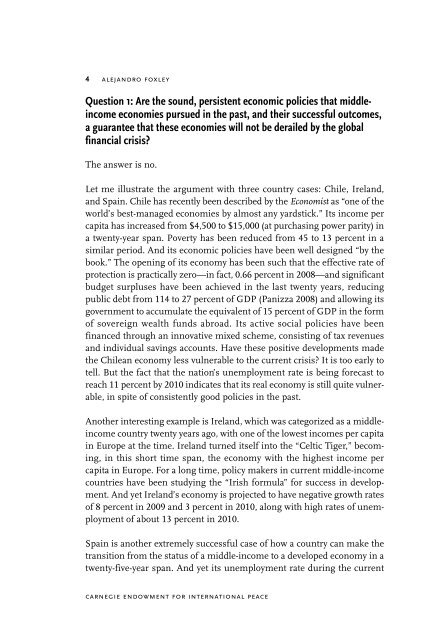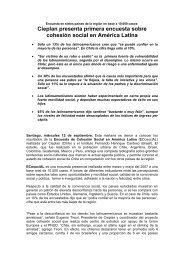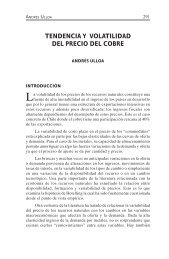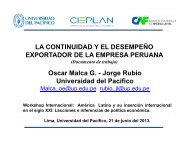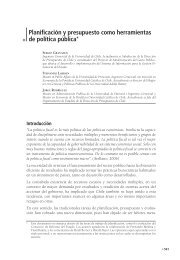Recovery: The Global Financial Crisis and Middle-Income Countries
Recovery: The Global Financial Crisis and Middle-Income Countries
Recovery: The Global Financial Crisis and Middle-Income Countries
You also want an ePaper? Increase the reach of your titles
YUMPU automatically turns print PDFs into web optimized ePapers that Google loves.
4 alej<strong>and</strong>ro foxleyQuestion 1: Are the sound, persistent economic policies that middleincomeeconomies pursued in the past, <strong>and</strong> their successful outcomes,a guarantee that these economies will not be derailed by the globalfinancial crisis?<strong>The</strong> answer is no.Let me illustrate the argument with three country cases: Chile, Irel<strong>and</strong>,<strong>and</strong> Spain. Chile has recently been described by the Economist as “one of theworld’s best- managed economies by almost any yardstick.” Its income percapita has increased from $4,500 to $15,000 (at purchasing power parity) ina twenty- year span. Poverty has been reduced from 45 to 13 percent in asimilar period. And its economic policies have been well designed “by thebook.” <strong>The</strong> opening of its economy has been such that the effective rate ofprotection is practically zero— in fact, 0.66 percent in 2008—<strong>and</strong> significantbudget surpluses have been achieved in the last twenty years, reducingpublic debt from 114 to 27 percent of GDP (Panizza 2008) <strong>and</strong> allowing itsgovernment to accumulate the equivalent of 15 percent of GDP in the formof sovereign wealth funds abroad. Its active social policies have beenfinanced through an innovative mixed scheme, consisting of tax revenues<strong>and</strong> individual savings accounts. Have these positive developments madethe Chilean economy less vulnerable to the current crisis? It is too early totell. But the fact that the nation’s unemployment rate is being forecast toreach 11 percent by 2010 indicates that its real economy is still quite vulnerable,in spite of consistently good policies in the past.Another interesting example is Irel<strong>and</strong>, which was categorized as a middleincomecountry twenty years ago, with one of the lowest incomes per capitain Europe at the time. Irel<strong>and</strong> turned itself into the “Celtic Tiger,” becoming,in this short time span, the economy with the highest income percapita in Europe. For a long time, policy makers in current middle- incomecountries have been studying the “Irish formula” for success in development.And yet Irel<strong>and</strong>’s economy is projected to have negative growth ratesof 8 percent in 2009 <strong>and</strong> 3 percent in 2010, along with high rates of unemploymentof about 13 percent in 2010.Spain is another extremely successful case of how a country can make thetransition from the status of a middle- income to a developed economy in atwenty- five- year span. And yet its unemployment rate during the currentcarnegie endowment for international peace


